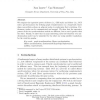Free Online Productivity Tools
i2Speak
i2Symbol
i2OCR
iTex2Img
iWeb2Print
iWeb2Shot
i2Type
iPdf2Split
iPdf2Merge
i2Bopomofo
i2Arabic
i2Style
i2Image
i2PDF
iLatex2Rtf
Sci2ools
ENTCS
2006
2006
Hoare vs Milner: Comparing Synchronizations in a Graphical Framework With Mobility
We compare the expressive power of Hoare (i.e., CSP style) and Milner (i.e., CCS style) synchronizations for defining graph transformations in a framework where edges can perform actions on adjacent nodes to synchronize their evolutions. Furthermore, nodes can be communicated and merged. We show that the expressive powers of the two synchronization models are different, but no one is greater than the other. Finally, we show that in many interesting cases the behaviour of a synchronization model can be mimicked by the other one using suitable translations for the rewritten graphs. Key words: graph transformations, Hoare synchronization, Milner synchronization, Synchronized Hyperedge Replacement, mobility, expressiveness.
| Added | 12 Dec 2010 |
| Updated | 12 Dec 2010 |
| Type | Journal |
| Year | 2006 |
| Where | ENTCS |
| Authors | Ivan Lanese, Ugo Montanari |
Comments (0)

